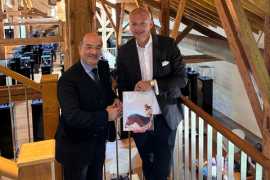UAE among top 10 countries for LEED Green Building: US Green Building Council Index
By olya Sunday, 09 August 2015 2:10 PM

The UAE led the Middle Eastern countries in green building applications, according to the U.S. Green Building Council (USGBC) international rankings of the top 10 countries for Leadership in Energy and Environmental Design (LEED) in 2015, the world's most widely used and recognised green building rating system.
'The United Arab Emirates (3.13 million of cumulative gross square metres, GSM) has had strong green building years. The UAE increased its total amount of LEED-certified space by 72 percent over last year, and climbed from ninth place overall in 2014 to eighth overall in 2015,' the USGBC said, noting that the UAE ranked ahead of Turkey and Sweden.
The total GSM of LEED-certified and registered space of the UAE is 53.44 million and with the total number of LEED-certified and registered projects at 910.
Commenting on the global landmark milestone, Abdullah Al Muaini, Director-General of the Emirates Authority for Standardisation and Metrology (ESMA), said, 'This new achievement is a fruit of the long-term national initiative launched by Vice President, Prime Minister and Ruler of Dubai, His Highness Sheikh Mohammed bin Rashid Al Maktoum in 2012 to build a green economy in the UAE under the slogan, 'Green Economy for Sustainable Development.' The new strategy aims to establish the UAE as a world leader in green economy and a centre for export and re-export of products and green technologies. It also aims to maintain a sustainable environment to support long-term economic growth.
The UAE seeks to be a global hub and a successful model of the green economy so as to enhance the competitiveness and sustainability of development being experienced by the country, and to preserve the environment for future generations.
The initiative includes a wide range of programmes and policies in the areas of energy, agriculture, investment and sustainable transport, in addition to environmental and constructional policies to raise the quality of life in the UAE.
'The ESMA is currently preparing a package of green applications which, when complete by the third quarter of 2015, will contribute to sharpen the nation's competitive edge globally,' he said, indicating that these programmes, which cover an array of fields like energy management systems, deployment of renewable energy, and environment efficiency of products, will enable the UAE to maintain its world leadership.
He admitted that raising energy efficiency of existing buildings would remain a tremendous challenge and requires all stakeholders to consider applicable technologies and mechanisms to reach that goal.
However, ESMA is ready to join forces with its strategic partners to implement its programme for rehabilitating these buildings in line with green building standards, he said.
He said that there was also a need to launch encouraging initiatives and creative funding solutions to implement energy efficiency strategies.
The ESMA chief explained that the UAE was the first GCC country to have introduced the Lighting Products and Lighting Products Control Regulation, which seeks to replace low quality, inefficient lighting products currently in the market with safe, high quality and energy efficient ones. Built on the European lighting system, the UAE model is one of the most important national strategies to reduce energy usage and protect the environment.
In introducing the lighting system, he said the UAE was expected to reduce energy consumption by 500 MW, which means the UAE can stop the operation of a medium gas-fired energy generation plant for six months.
The U.S. Green Building Council (USGBC) said the Top 10 list highlights countries outside of the U.S. that are making significant strides in sustainable building design, construction and transformation, illustrating the ever-growing international demand for LEED green buildings. The announcement comes at a time of increased international focus on climate change mitigation in the lead up to the United Nations' COP21 climate negotiations this December.
"International demand has grown steadily for tools supporting sustainable economic growth, and it has become increasingly clear that we are reaching a tipping point around environmental sustainability. It is now impossible to view social and economic development as separate issues from a robust sustainability agenda," said Rick Fedrizzi, CEO and founding chair, USGBC. "The global success of LEED in these countries is a sign that international business leaders and policy makers recognise that a commitment to transforming the built environment is crucial to addressing major environmental challenges. The countries on this list are pushing this commitment forward."
The 10 countries that made the list for 2015 are geographically and culturally diverse, representing seven of the world's 20 largest single-nation economies by gross domestic product (GDP) (China, Germany, Brazil, India, Canada, South Korea and Turkey), as well as six of the top 11 emitters of greenhouse gases (China, India, Germany, South Korea, Canada and Brazil). While Canada tops the list, Brazil and the Republic of Korea have moved up in the rankings and Turkey and Sweden are new to the Top 10 this year.
This is the second year that USGBC has provided rankings on the Top 10 Countries for LEED outside of the U.S. The analysis used to develop the list ranks countries in terms of gross square meters and numbers of LEED projects to date. LEED-certified spaces use less energy and water resources, save money for families, businesses and taxpayers, reduce carbon emissions and create a healthier environment for residents, workers and the larger community. The U.S., the birthplace of LEED, is not included in this list but remains the world's largest market for LEED. The U.S. is the world's largest economy by GDP as well as the world's second largest emitter of greenhouse gases.
Every day, nearly 172,000 GSM of space is certified using LEED, and there are currently more than 69,800 commercial and institutional projects representing 1.23 billion GSM of space participating in the green building rating system. An additional 76,500 residential units have been certified under LEED for Homes. LEED projects can now be found in more than 150 countries and territories across the world.
Canada ranks number one on the list as the largest user of LEED outside of the U.S. with 26.63 million GSM of LEED space. There are now over 4,814 LEED-registered and LEED-certified projects representing 63.31 million GSM of LEED space in Canada. China (21.97 million GSM), India (13.24 million GSM) and Brazil (5.22 million GSM), three of the four BRIC economies, finished second through fourth on this year's list, respectively. These three countries currently represent more than 33 percent of global greenhouse gas emissions, with China and India representing the largest source of projected growth in global emissions in the coming decades.
The Republic of Korea (4.81 million GSM) and Taiwan (3.84 million GSM) join China in providing a strong East Asian contingent to the 2015 rankings. Having two of the original tiger economies join China, India and Brazil on this year's list demonstrates that LEED is taking hold in some of the world's fastest growing economies, and that green buildings have enormous strategic value in terms of controlling emissions in countries that many climate watchers have noted hold the key to staving off the worst impacts of climate change.
Germany (4.01 million GSM) and Sweden (2.54 million GSM) represent Europe on this list, with Germany finishing sixth and Sweden making the list for the first time in 10th place. Both nations are routinely cited for their innovation and leadership in international efforts to reduce greenhouse gas emissions.
Middle Eastern countries, United Arab Emirates (3.13 million GSM) and Turkey (2.95 million GSM) have both had strong green building years. The UAE increased its total amount of LEED-certified space by 72 percent over last year, and climbed from ninth place overall in 2014 to eighth overall in 2015. Turkey made the Top 10 list for the first time in the nation's history, finishing ninth overall. – Emirates News Agency, WAM




























Add new comment